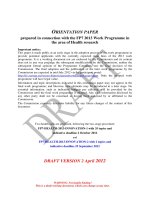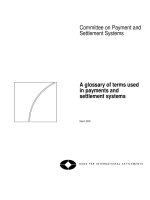Optimizing dimension of heat sink’s plate fin with the effect of wind velocity in site router tecommunication system
Bạn đang xem bản rút gọn của tài liệu. Xem và tải ngay bản đầy đủ của tài liệu tại đây (725.87 KB, 5 trang )
ISSN 1859-1531 - THE UNIVERSITY OF DANANG, JOURNAL OF SCIENCE AND TECHNOLOGY, NO. 12(133).2018
19
OPTIMIZING DIMENSION OF HEAT SINK’S PLATE FIN WITH THE EFFECT
OF WIND VELOCITY IN SITE ROUTER TECOMMUNICATION SYSTEM
Viet Dang-Thai, Thong Dinh-Sy
Hanoi University of Science and Technology; ,
Abstract - Nowadays, heat dissipation for electronic chips,
microprocessors in electrical and electronic equipment, especially
in Site Router telecommunication equipment when operating at
high intensity is an urgent process to increase life expectancy,
productivity and performance. Many telecom providers such as
Huawei, Ericsson, Cisco etc have offered solutions for liquid
cooling, cold air, heat pipes. However, the complexity, the cost and
the effect are not high. Furthermore, there is shortage in optimal
parameters of design and operation [1-5]. Derived from the above
fact, the author has calculated and modeled a Site Router
equipment using extruded blast heat exchanger with a large heat
exchanger structure which withstands pressure when falling,
combining airflow from fans to speed up the dissipation of heat. In
this paper, the author presents the optimal calculation and control
process of the size of the heat sink and the contact plate under the
influence of actual operation conditions at the specified velocity of
the air flow from which the model is built directly to determine the
number and the size of the heat sink’s plate fins.
Key words - Airflow; cooling process; heat dissipation; optimal
control; SiteRouter equipment.
1. Nomanclature
A: Surface area in m2.
Ac: Cross-sectional area in m2.
Af = H.W: Total frontal area of heatsink.
Ap: Fin profile area.
α: The convective heat transfer coefficient depends on
a number of parameters determined by experiment
(W/m2.K).
b: Fin spacing in m.
C=120: Sutherland's constant for air.
F: surface area of heat exchanger (m2).
H: Fin height in m.
k= 209: Thermal conductivity of Al6063-T5 (W/m.K).
θb: Temperature excess = Tb- T0(K,0C).
λ: Thermal conductivity of the material (W/m.K).
L: Fin length in m.
μ: Dynamic viscosity at input temperature T0.
μ0= 18,27x10-6 Viscosity reference at standard
temperature T0.
N=
W −t
b+t
+1
: Number of fins.
Qx: X- axis heat transfer for 1 second (W).
Q: Heat dissipates in a second of the object (W).
qx: The density of the heat transfer current in the
direction x (W/m2).
Rɵ: Thermal resistance (K/W).
Rsink: Thermal resistance of heatsink.
Rfin: Thermal resistance of each fin.
T: The absolute temperature of the object (K).
ΔT = T1-T2: The difference in wall thickness (K).
Tw: Average temperature of the object (K,0C).
Tf: Average temperature of the gas or liquid (K,0C).
T0=291,15: Standard temperature of air (K).
T0=273+55: Absolute temperature environment (K).
t: Thickness of fin.
tb: Thickness of base.
W: Width of heatsink.
2. Introduction
Today's thermal technology evolves from material to
heat dissipation for liquid, nitrogen, gas or heatpipe
applications such as "Laser-cooling Brings Large Object
Near Absolute Zero" by Hänsch and Schawlow [7].
The variety of solutions offers great efficiency for
devices that require large amounts of heat dissipation.
However, the complex structure and the need for external
power sources such as heat pumps have increased costs and
are difficult to implement for limited-sized devices such as
SiteRouter. One of the studies: "Design and Optimization
of Horizontally-Finished Plate HeatSink for High Power
LED street lamps" by Xiaobing Luo and Wei Xiong [6]
launched in 2009 has reduced the complexity of liquidliquid heat sinks as well as the use of extruded extruded
heatsinks to optimize heat dissipation.The study has
created the premise for the placement of heatsinks in
telecommunication equipment with optimal size compact.
However, the new study stops at passive heat dissipation
through radiation and convection without impact from
wind flow.
Based on the research on extruded bladed heat
exchanger, the team combined the airflow through the
layout solution of the blower in the SiteRouter, calculating
the fin height adjustment and the distance between the fins.
heat dissipation to reduce the heat at specified values of
wind speed, increase the ability to dissipate heat to the
environment. The obtained results are achieved through
using NLP solve optimization function on Maple for the
heat dissipation of Site Router’s Mathematic model [8].
3. Method
SiteRouter equipment is modeled by using built-in fan
housings on the air flow bushes directly into the extrudedfins heatsink. At fixed velocities of 1 m/s, 5 m/s the authors
calculate the thickness of profiles of the fins as well as the
distance between the adjacent fins from which the number
of heat sink flutes is matched for the highest heat
dissipation effect
20
Viet Dang-Thai, Thong Dinh-Sy
3.1. Thermal conductivity
Thermal conductivity occurs due to the difference in
temperature between regions in a solid or between two
solid objects in contact. General heat conduction [4, 5] is:
Q x = − F
3.2. Convection
Q
T
T
( W ) → qx = x = −
( W / m2 ) (1)
x
F
x
in case of flat wall (application of heat dissipation
calculation)
Q = F
T
=
Figure 3. Convection process
T
(W) → R =
(K/ W, 0 C/ W) (2)
R
F
with λ: Thermal conductivity of the material (W/m.K).
Diamonds, silver and copper have very good thermal
conductivity (see table 1). However, most manufacturers
use aluminum as their primary material. The main reason
is that aluminum is available, cheap and easy to make.
Besides, another important factor affecting the heat
dissipation quality is the ability to radiate (Copper is able
to emit less heat than aluminum).
In this paper, the main purpose is to analyze geometric
parameters of heatsinks and based on the thermal
conductivity and manufacturing capability. The author
uses the Al 6063-T5 aluminum for the heatsink of
SiteRouter equipment.
Figure 4. Thermodynamic model
Convection is the process of heat exchange that occurs
when a surface of a solid comes into the contact with a
liquid or gaseous environment at different temperatures.
To calculate the heat in the convection process we use
the Newton formula as follows:
Q = F (Tw − T f ) =
Tw − T f
R
( W)
1
(K/ W, 0 C/ W)
F
3.3. Influence of geometric parameters
dissipation to heat dissipation
(3)
→ R =
of
heat
Figure 1. Conduct heat from high temperature to low temperature
Figure 5. Structure of Heatsinks
The energy equation for the heat exchanger has the
effect of the external air flow of the heat sink [3]:
•
S
Figure 2. Heat conduction through flat wall and equivalent heat
Table 1. Table of thermal conductivity of
some heat dissipation materials
gen
While
=
Q b
T0
b
2
+
Fd Vf
(4)
T0
= Q.Rsink
(5)
2
•
From (4) and (5):
S
gen
=
QR
T
sink
2
+
FV
T
d
f
(6)
0
0
Thermal resistance of the heatsink:
R
sink
1
=
(N/
R
) + h(N − 1) bL
fin
+
t
b
(7)
kLW
Thermal resistance of each fin:
R
fin
1
=
hPk
A
c
tanh(mH)
8)
ISSN 1859-1531 - THE UNIVERSITY OF DANANG, JOURNAL OF SCIENCE AND TECHNOLOGY, NO. 12(133).2018
With:
hP
m=
k
A
(9)
c
Force acting on the heatsink surface under the effect of air
flow:
F
d
2
(1 2)
V
=
N (2 HL + bL) +
f
K (HW) + K (HW)
c
app
(10)
e
ch
Free flow velocity:
V
ch
=
V
f
t
(1 + )
b
(11)
f app R eD =
h
with: L
*
*
L
3.44
2
12
2
+ f R eD
h
(12)
L
=
(13)
DR
h
Q = 25W; L=60.10−3m; W = 60.10−3 m; H=25.10−3m;
𝑏
≥ 0.28 to remove the
radiation directly from the surface of the heatsinks to the
opposite heatsinks surface.
Case 1: At wind speed of 1 m/s
The NLP Solve command solves a nonlinear
program (NLP), which involves computing the
minimum (or maximum) of an objective function, possibly
subject to constraints [8]. Therefore, using the NLP solve
optimization function on Maple, we obtain the optimal
solution b, t for heat dissipation:
𝐻
eD
h
b
b
) + 46.721( ) 2
H
H
b 3
b 4
b
−40.829( ) + 22.954( ) − 6.089( ) 5
H
H
H
fReDh = 24 − 32.527(
Kc = 0.42(1 − (1−
R sink = R sink (L, H, t b , W, b, t, … ) = R sink (x1 , x2 , x3 , … )
→ min
Because the size and working space of the device is
limited, the parameters L, H, W are fixed. Therefore, the
optimal performance of heat dissipation based on
optimizing the remaining parameters of the heatsink
includes: b, t, tb.
Apply with practical parameters for experiment:
t b = 2.10−3 m with condition:
For laminar flow:
21
N .t
W
2
)
Nt
(14)
Solve = [2.26046585938925793, b=0.00545000000000002,
t=0,000779266948589301]
2
) and K e = (1 − (1− ) )
W
2
(15)
The equation of heat transfer coefficient:
−1/3
−3
−3
Reb* Pr
3.65
*
1/3
Nub =
1+
+ 0.664 Reb .Pr
*
2
Re
b
(16)
b
L
Re b * = Re b
h=
(17)
kf .Nub
b
(18)
Reynolds factor: R eDh =
Therefore: R eD =
Dh .Vch
(19)
Kinematic viscosity:
h
=
(T 0 + C ) T0
.
; = 0
T0 + C
T0
3/ 2
(20)
4. Parameters optimized with empirical model
Based on the energy equation Entropy (4), we can
optimize any of the parameters for the size of the heat sink:
•
S gen
x
=0
Ṡgen = Ṡgen (L, H, t b , W, b, t … ) = Ṡgen (x1 , x2 , x3 , … )
→ min
The following optimal number of heat sink’s fin
optimizes t parameters:
N=
; Dh = 2.b .
2.b.Vch
Figure 6. The graph shows the relationship between Rsink heat
dissipation with fin’s thickness t at wind speed of 1 m/s.
(21)
W −t
b+t
−3
+1 =
60.10 − 0, 000779
−3
5, 45.10 + 0, 000779
= 10 ( fins )
(22)
Use Ansys IcePack to simulate 3 cases with other fin’s
number:
a) N= 15, ambient temperature 550C, the highest heat
gain on the heat sink 91,7862 0C.
22
Viet Dang-Thai, Thong Dinh-Sy
0
b) N=8, ambient temperature 55 C, the highest heat
gain on the heat sink 93,7176 0C.
The following optimal number of heat sink’s fin
optimizes t parameters:
N=
c) Optimized parameters N=10, ambient temperature
55 0C, the highest heat gain on the heat sink 90,1244 0C.
W −t
b+t
+1 =
60.10
7.10
−3
−3
− 0, 00137
+ 0, 00137
= 8( fins )
Number of fins is a positive integer, so in the low
velocity range from 1 ÷ 10 m/s the number of fins changing
10 ÷ 8 fins does not clearly show the change of temperature
when the velocity adjustment amplitude is small.
Therefore, based on the calculation of the thickness of
the fin, we compare the temperature when the fins have
different thicknesses.
a) t= 0.8 mm, ambient temperature 550C, the highest
heat gain on the heatsink 71,60410C.
b) t= 2,5 mm, ambient temperature 550C, the highest
heat gain on the heatsink 72,09220C.
Figure 7. The comparison about the highest heat gain between
the different N of heatsink at ambient temperature 550C
Combining the calculated resuslt of eq. (22) with the
experiment simulation, at the N=10 at the fixed ambiend
temperature 55oC, the best highest gain on the heat sink is
90,1244oC. The obtained result is compared with the
number of fin N=15 (is larger than 10) and N=8 (is smaller
than 10). Thus, the optimized parameter N is 10 which is
really suitable with the theory calculation in (22).
Case 2: At wind speed of 5 m/s:
Using the NLP solve optimization function on Maple
we obtain the optimal solution b, t for the heat dissipation:
c) Optimized parameters t = 1 mm, ambient temperature
Solve = [1.36539969526120397, b=0.00700000000000009, 550C, the highest heat gain on the heatsink 70,1067 0C.
t=0,00137701437586191]
Figure 8. The graph shows the relationship between Rsink heat
dissipation with fin’s thickness t at wind speed of 5 m/s
Figure 9. The comparison about the highest heat gain between
the different fin’s thicknesses at ambient temperature 550C
ISSN 1859-1531 - THE UNIVERSITY OF DANANG, JOURNAL OF SCIENCE AND TECHNOLOGY, NO. 12(133).2018
The results show the relationship between the
geometric parameters of the extruded bladed heatsinks and
the effect of magnetic force from the wind, thus providing
the most suitable and effective thermal dissipation for Site
Router equipment at the certain velocity values of the wind.
Obtained achievements should extend the radiated energy
of the heatsink when the wind velocity condition is
constant. The work finds out optimal parameters for the
profile, heat sink and fan speed control that help the device
to achieve the highest thermal dissipation efficiency.
5. Conclusion
Derived from the obtained results of module Al 6063T5 heatsink of the Site Router, the author has calculated
and modeled Site Router equipment using extruded blast
heat exchanger with a large heat exchanger structure which
withstands pressure when falling, combining the airflow
from the fans to speed up the dissipation of heat. In this
paper, the author discusses optimal process of size of the
heat sinks and the contact plate is calculated under the
influence of actual operating conditions at the specified
velocity of the air flow from which the model is built
directly to determine the number and the size of plate fin
heatsinks. Using the NLP solve optimization function on
Maple, we obtain the optimal solution b, t for heat
dissipation. Finally, the author has completely defined
experimental relationship of characteristic lines between
23
Rsink heat dissipation with wing thickness t in Figures 7
and 8 with the obtained optimized parameters.
Acknowledgments
This research was funded by the Vietnam National
Foundation for Science and Technology Development
(NAFOSTED) under the project number 107.03-2013.15.
REFERENCES
[1] A. Bejian, Entropy Generation Through Heat and Fluid Flow, New
York, Wiley, 1982.
[2] W.M. Kays and A.L.London, Compact Heat Exchangers, New
York, McGraw-Hill,1984.
[3] A. Bejian, Entropy Generation Minimization, Boca Raton, FL, CRC
Press, 1996.
[4] PGS. TS. Võ Chí Chính, “Kỹ Thuật Nhiệt”, Scientific and Technical
Publishing Hà Nội, 2006.
[5] PGS. TS. Nguyễn Bốn, “Nhiệt Kỹ Thuật”, Scientific and Technical
Publishing Hà Nội, 2003.
[6] Xiaobing Luo and Wei Xiong, “Design and Optimization of
Horizontally- located Plate Fin Heat Sink for High Power LED street
Lamps”, IEEE, China, (2009).
[7] Ir. C. J. M. Lasance, “Heat transfer Theory applied to Thermal
Design and Cooling of Electronics Workshop”, Philips Research,
(2003).
[8] I. Castillo, T. Lee and J. D. Pinter, “Integrated Software Tools for
the OR/MS Classroom”, Algorithmic Operations Research, Vol.3
(2008) 82–91.
(The Board of Editors received the paper on 09/7/2018, its review was completed on 04/9/2018)









